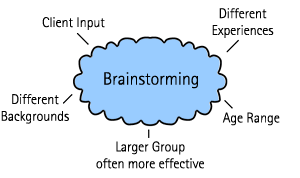|
| |
 |
| Design Methods and Practical Development |
|
Developing Concepts |
Brilliant ideas don't always come to you in a flash of inspiration.
Finding the right idea can mean a drawn out process of research,
teamwork and collaboration preferably with both the team and the
client involved. Many people use notebooks or scrapbooks to help
them remember ideas and develop concepts.
 |
Usually the good ideas come, I would say,
like a flash. Either you've got it first time round
or you start from scratch. I think my good ideas are
the first ones I have, but sometimes I'm just trying
to re-work something. Tim Clark |
 |
|
 |
The best thing a designer can do is use
their eyes. You just make sure that when you see things
that you really, really like you take them in and you
make sure you use them and keep them in the back of
your head for the future. Michael Ellott |
 |
|
A good indication that you have found an idea that works is when
you are able to sum it up in one line - the pitch line. It is
essential to be able to be able to sum up your idea in a few words.
Inability to do this often means your idea needs further work.
The best ideas are usually fairly simple and needn't take up more
than a side or two of A4 paper.
 |
We've sold shows before on three sides
of paper and that's always the way we first go. Some
formats don't need you to do anything else before you
sell it. I think we sold Bar Wars pretty much as a proposal
and it was because it's a fairly simple idea. David
Flynn |
 |
|
Also remember that in multimedia creative ideas have to work
technically so be aware of time and cost constraints when thinking
the idea through. When embarking on the creative process, think
about what it is you are trying to communicate.
 |
Brainstorming can be an extremely effective method of generating
ideas. If an idea you originally thought would work turns
out to be unsuitable, most designers and producers will save
it because although it may not be suitable for the particular
project you are working on, it may suit something else later
on. |
Ideas are essentially invisible, so when coming up with them
try to think conceptually as you will need to communicate your
ideas to your client at a fairly early stage.
Everything and anything can give you inspiration. Your surroundings
may trigger a reaction but you might not realise you have been
inspired until later. Ideas can come from everywhere and at any
time so use your eyes. A lot of designers also surround themselves
with conceptual design and inspirational work to keep them motivated
and on track. Often designers and developers create mood boards
to give a feel for a certain product.
 |
There are two ways of doing things. There's
that flash of inspiration that we don't know where it
comes from - it might not even be project specific.
The other side of that is what you define as the slog
and it's the process that you go through, then you come
up with some ideas. Sometimes out of that you get a
flash as well, but quite often you don't. Grant
Campbell |
 |
|
|
| |
 |
| How do you find a good
idea or concept? |
|
 |
|
 |
|
 |
|
 |
|
 |
|
 |
|
|
|
Most clients like to feel that they are part of
the creative process, but how this is defined in practice depends
on the relationship between parties. However, the client ultimately
needs to like and understand the idea before you can implement
it, so whether it comes from them or from the designer or producer,
good communication is the key to a good collaboration.
|
| |
|

